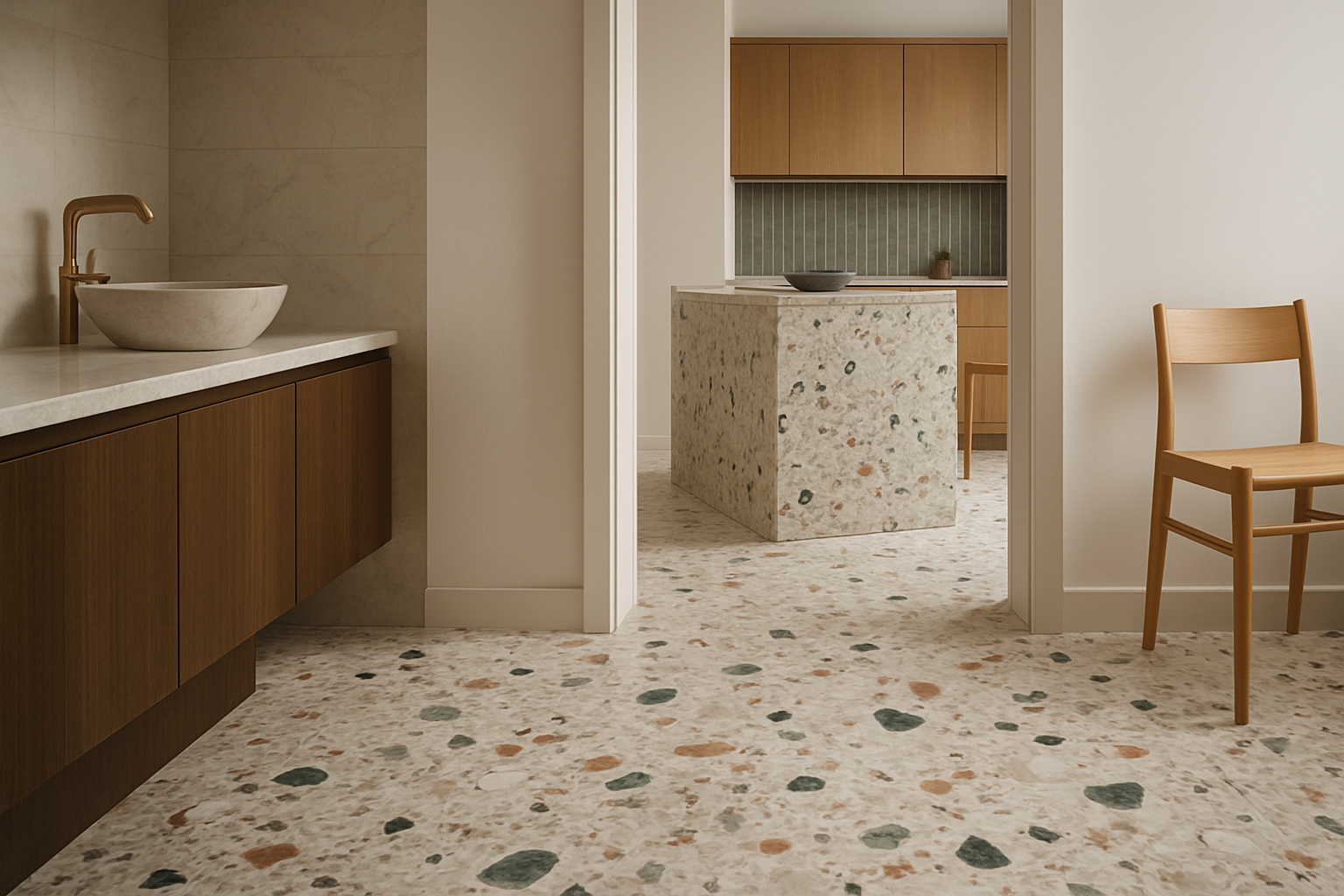Terrazzo Revival: Bridging Timeless Charm with Modern Aesthetics
Terrazzo, the speckled composite material once relegated to institutional flooring, is experiencing a remarkable renaissance in contemporary home design. This resurgence breathes new life into an age-old technique, transforming it from a utilitarian surface into a versatile, stylish element that's capturing the imagination of designers and homeowners alike. As we delve into the world of terrazzo, we'll explore its rich history, modern applications, and the innovative ways it's being reimagined for today's interiors.

A Storied Past Meets Modern Innovation
Terrazzo’s origins can be traced back to 15th century Venice, where resourceful marble workers repurposed leftover chips by embedding them in clay to create durable, decorative surfaces for their terraces. This ingenious upcycling technique gave birth to the name terrazzo, Italian for terrace. Over centuries, the craft evolved, spreading across Europe and eventually making its way to the United States in the late 19th century.
The material hit its stride during the Art Deco movement of the 1920s and 30s, adorning the floors of grand hotels, government buildings, and even the Hollywood Walk of Fame. However, as modernist aesthetics took hold in the mid-20th century, terrazzo fell out of favor, often associated with sterile, institutional environments.
Today’s terrazzo revival is driven by advancements in manufacturing techniques and a renewed appreciation for artisanal craftsmanship. Modern terrazzo can be poured in place or pre-cast, offering flexibility in application and design. The introduction of epoxy-based terrazzo has expanded color options and improved durability, making it suitable for a wider range of residential applications.
Beyond the Floor: Terrazzo’s Versatile Applications
While terrazzo flooring remains a popular choice, innovative designers are pushing the boundaries of its application. Countertops, backsplashes, and even furniture pieces are now showcasing the material’s versatility. In bathrooms, terrazzo shower walls and vanities create a seamless, waterproof surface that’s both beautiful and practical.
One of the most exciting trends is the use of oversized aggregate in terrazzo. This technique creates bold, graphic patterns that serve as focal points in minimalist interiors. Imagine a living room featuring a coffee table with large, colorful stone chips suspended in a neutral base – a functional piece of art that anchors the entire space.
Terrazzo is also making waves in the world of accessories and small home goods. From planters and lamp bases to coasters and serving trays, these pieces allow homeowners to incorporate the terrazzo trend without committing to large-scale installations.
Customization: The Key to Terrazzo’s Appeal
One of terrazzo’s greatest strengths is its infinite customizability. Designers and homeowners can select from a vast array of aggregate materials, colors, and binder options to create a truly bespoke look. This level of personalization allows terrazzo to complement any design aesthetic, from sleek and modern to warm and eclectic.
The ability to incorporate unexpected elements into terrazzo is sparking creative experimentation. Some designers are embedding brass or copper inlays to create geometric patterns, while others are using recycled glass or even plastic to produce eco-friendly surfaces with a unique story.
Color choices are evolving as well. While traditional terrazzo often featured neutral tones, today’s palettes are bold and expressive. Pastel pinks and blues reminiscent of 1980s Miami are gaining popularity, as are deep, moody hues that add sophistication to contemporary spaces.
Sustainability Meets Style
As environmental consciousness grows in the design world, terrazzo is emerging as a sustainable choice for eco-minded homeowners. Many terrazzo mixes incorporate recycled materials, from post-consumer glass to reclaimed marble. This not only reduces waste but also creates one-of-a-kind surfaces with a rich backstory.
The longevity of terrazzo is another factor in its sustainability profile. When properly installed and maintained, terrazzo can last for decades, reducing the need for frequent replacements. Its durability makes it an excellent choice for high-traffic areas in both residential and commercial settings.
Moreover, the production of terrazzo often has a lower carbon footprint compared to some other surface materials, especially when using locally sourced aggregates and low-VOC binders. As the demand for sustainable building materials grows, terrazzo is well-positioned to meet both environmental and aesthetic requirements.
DIY Terrazzo: Bringing the Trend Home
While traditional terrazzo installation requires specialized skills, the trend has inspired a wave of DIY projects that capture the essence of the material. Crafty homeowners are creating terrazzo-inspired surfaces using polymer clay, resin, or even paint techniques to mimic the speckled appearance.
These DIY approaches allow for experimentation with color and pattern on a smaller scale. From painted accent walls that mimic terrazzo’s signature speckles to homemade planters adorned with colorful chips, these projects offer an accessible entry point to the trend.
For those looking to incorporate authentic terrazzo without a full renovation, pre-cast terrazzo tiles are becoming increasingly available. These can be used to create striking backsplashes, tabletops, or even outdoor patios, bringing a touch of terrazzo’s charm to any space.
The Future of Terrazzo in Home Design
As terrazzo continues to evolve, we can expect to see even more innovative applications and techniques. The integration of smart technology, such as embedded LED lights or conductive materials for wireless charging surfaces, could take terrazzo into futuristic territory.
The material’s adaptability also positions it well for the growing trend of biophilic design. By incorporating natural elements like shell fragments or small pebbles, terrazzo can create a connection to nature within interior spaces, promoting wellbeing and a sense of calm.
As we look to the future, it’s clear that terrazzo’s renaissance is more than just a passing fad. Its blend of history, craftsmanship, and modern innovation makes it a material that’s both timeless and contemporary. Whether used as a statement floor, a unique furniture piece, or a subtle accent, terrazzo is proving that sometimes the most exciting design trends are those that reinvent the classics for a new generation.





